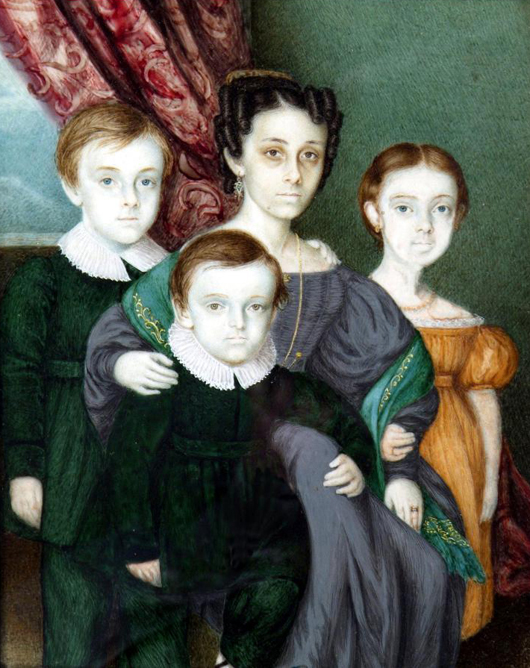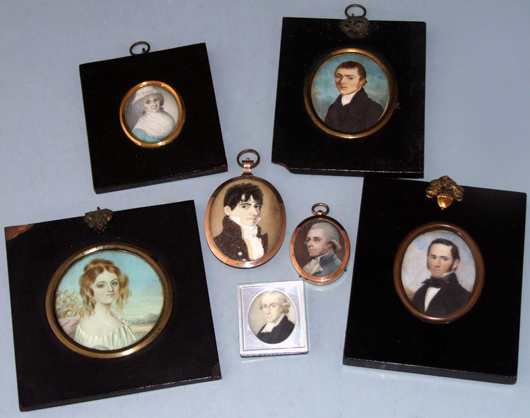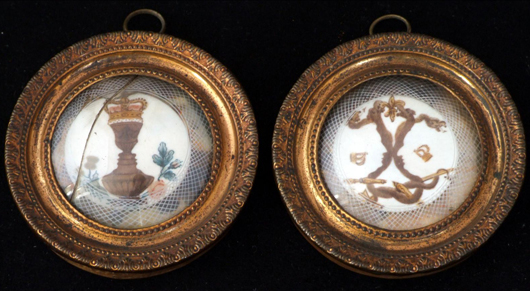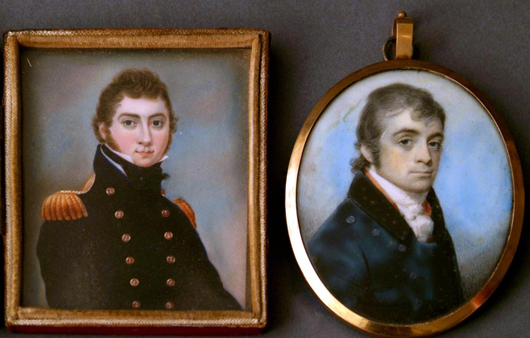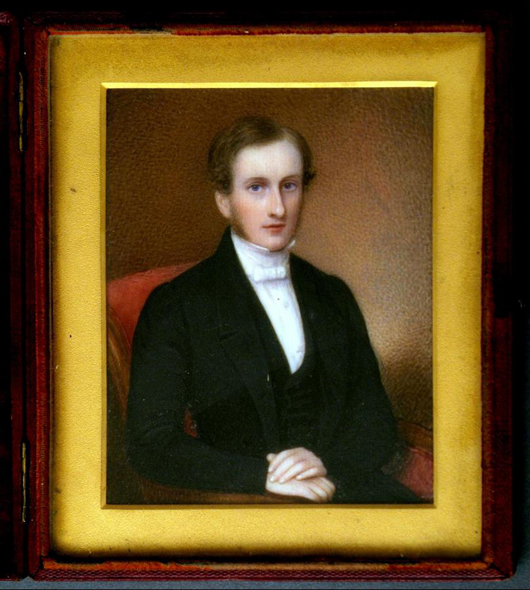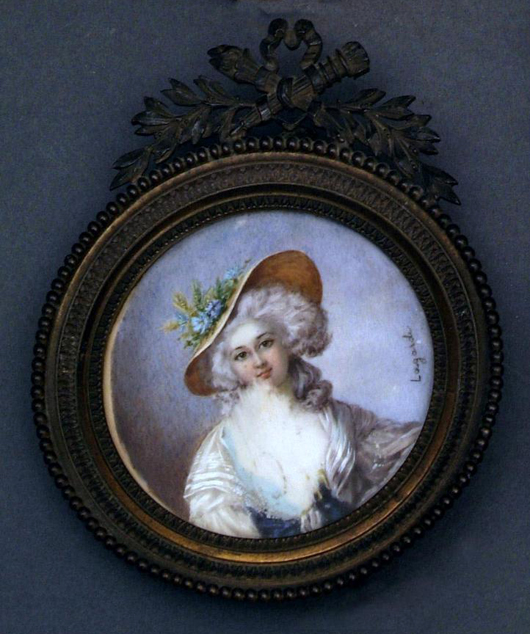
LONDON – The sale by Peter Wilson Auctioneers was on the day that Scotland voted to stay in the Union (hurrah), so it was an auspicious moment for the miniature paintings illustrated here to come under the hammer. Here in the form of two, 2-inch wide, pictures was a quick history lesson on the English and French constitutions and the state of the latter following the French Revolution.
But first, can you see the profiles in the tiny optical illusions? France was first with prints employing the trickery, but it was subsequently developed in about 1915 by Danish psychologist Edgar Rubin and popularized as Rubin’s Vase. Recognition requires something the shrinks call “higher cortical processing.”
On the left is England, with Queen Charlotte and George III created in the white space by the outline of the central pillar and urn, capped by the glorious English crown, solid and dependable. To the left is the Scottish thistle; to the right, the English rose, both surrounded by English oak leaves.
In contrast, the miniature on the right shows the profiles of Marie Antoinette and King Louis XVI, created by the coiling body of a ferocious Hydra, which has torn through the French monarchy. This is represented by the broken crown, superimposed on the monarchs’ heads, and shown falling to the ground, while the fleur-de-lis, the famous symbol of the House of Bourbon, is about to be swallowed by the many-headed serpent.
Known as “urnes mystérieuse,” the pair of 18th century circular miniatures painted in watercolour on ivory carry messages steeped in historical propaganda. Pieces such as this were ordered by royalist sympathizers lamenting the 1793 overthrow on the monarchy. The fact was not lost on the auctiongoers. Estimated at £200-400, they sold to a private collector for £1,300.
In a nutshell, that is the joy of miniatures. While few are optical illusions, all are historically important records of what our ancestors looked like, before the advent of the camera.
Portraiture is the branch of painting most encouraged by the English and of its branches; miniature painting has the longest native tradition. The careers and work of Hans Holbein, Nicholas Hilliard, Samuel Cooper, Richard Cosway, John Smart and Sir William Charles Ross form an almost unbroken line of unsurpassed excellence over three centuries.
The portrait miniature began in the early years of the 16th century through, it is thought, the function of two separate streams of tradition. One was the illuminated manuscript, which had a history extending over 1,000 years. The other was the portrait medal. The contribution of the manuscript, however, is considered of paramount importance. The mediaeval limner, as he was called, painted with excellence on vellum, his watercolors producing a glowing page bettered only by a stained glass window.
The history of the English portrait miniature begins with those painted by Holbein during his visit to England from Antwerp between 1532 and his death in 1543. Holbein is known to have painted a number of members of the court of King Henry VIII, but his work is rare. Only about 12 miniatures have been safely assigned to him. Holbein’s likeness of Anne of Cleves, Henry’s fourth wife, can be seen in the Victoria & Albert Museum.
Holbein taught Queen Elizabeth I’s limner and miniature painter, Nicholas Hilliard, the first great English miniature painter, whose brilliant career spanned from 1560 until his death in 1616. He produced a large number of excellent miniatures and examples are, surprisingly, not rare and not always expensive. Another of his most important legacies was his treatise on the subject, written in about 1600.
However, the mid-17th century was dominated by John Hoskins and the greatest miniaturist of them all, Samuel Cooper, whose work ranks among the finest productions of the English School of painting. Cooper was the nephew of Hoskins and was taught by him but the effect of Van Dyke’s arrival in England in about 1636 probably influenced him more than anything else.
Cooper was active as a Royalist supporter during the Civil Wars, although his unfinished miniature of Oliver Cromwell in the Buccleuch Collection probably ranks as his masterpiece. His royal miniature of Charles II at Goodwood has a pomp and majesty that leaves the spectator transfixed.
Earliest miniatures were circular in shape but after 1580, oval became most popular. Rectangular shapes were also common and frames were made from ivory, gold and silver, sometimes studded with enamel or precious jewels. In early examples, vellum was most commonly used for the base of the picture.
Colors were ground by the artist and mixed with gum arabic dissolved in hot water. The opaque and brilliant gouache produced was applied directly to the vellum, sometimes with pure gold leaf added in powder form as an extra embellishment.
Probably the biggest influence on the success of the portrait miniature was the introduction of ivory as a medium. Although first employed in Italy in the 1720s, it took nearly 60 years to develop, and it was not until John Smart and Richard Cosway adopted it that the full use of ivory as a medium was properly explored.
The third quarter of the 18th century was the golden age of the portrait miniature. Patronage from wealthy tradesmen, landowners, aristocracy and gentry was at its height and competition among artists opened up the availability of the art.
However, miniatures produced in the early years of the 19th century, though technically competent, are less attractive than those of the preceding decades. They reflect the rather dull costume of the period: women’s’ dresses were often simple and colorless, and men’s outfits were usually plain, mostly black or dark blue, occasionally relieved by a colored waistcoat.
Naturally enough, the vogue for photography, starting in the 1840s, dealt a serious blow to miniature painting, which by 1860 had lost much of its popularity. The accuracy of the photograph could not be matched, and neither could the speed nor the cost.
The biggest problem facing today’s collector is weeding out the ever-growing number of fakes. Less convincing copies are clumsily executed, poorly drawn and characterless. Look for stippled painting rather than crisscross or hatched brush strokes, while the texture of the ivory used is another pointer. You’re looking at a forgery if the slip is polished on both sides. An original would have been polished only on the painted side.
Indeed, occasionally even the painted surface appears to have been roughened slightly so that the paint would “bite,” or adhere better. In some cases scientific testing of the paint and other materials is the only sure course, although only the most well-heeled collectors are likely to be in it at this level. Don’t be put off, though. Buy your collection from a reliable source, either a dealer or saleroom where purchases are guaranteed.
A pointer for dating miniatures is their size. Generally speaking, the smaller they are, the earlier they date. Size tended to increase during the 1770s, possibly to enable artists to include the flamboyant hairstyles of the period.
Hang collections of miniatures away from strong sunlight, which fades colours, and avoiding temperature or humidity changes, which causes cracking and deterioration. Restoration is the preserve of the expert – and the bill will be far from miniature.

ADDITIONAL IMAGES OF NOTE
